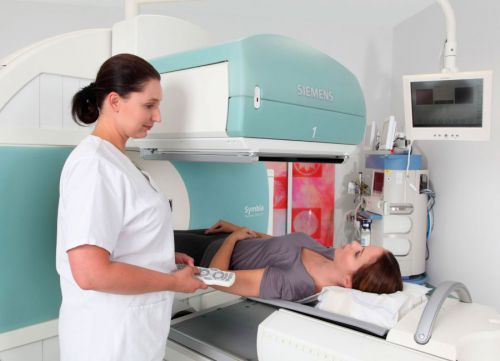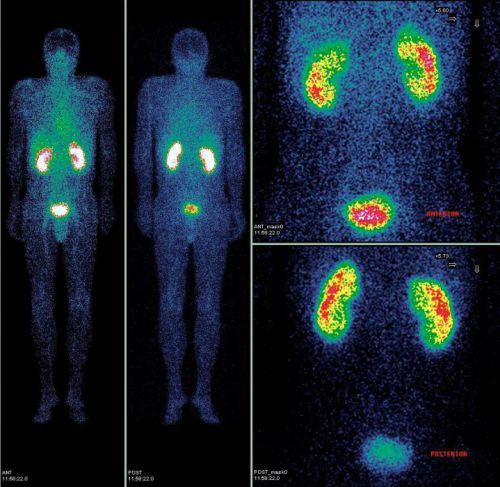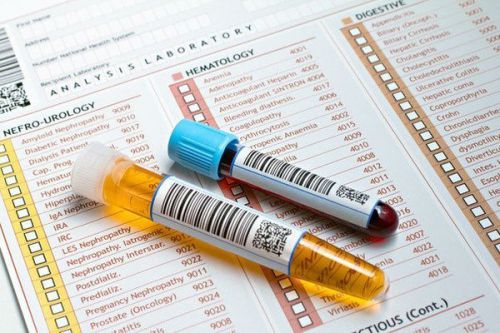Neprezentare, or renal scintigraphy, based on intravenous administration to the human body of medicines, which are used as radioactive tracer.
Drugs moving through the veins, arteries, capillaries and leave traces (gamma photons). A special device of the detector detects the movement of radioisotopes and visualizes them on the screen of the device in the form of three-dimensional images and charts.
Renal scintigraphy is a modern method of diagnosis, which is based on contacting authorities with the drug having the properties of a radioisotope. The study can not only evaluate the condition of the tissues, but functionally visualize.
After the procedure the patient receives high-precision images needed by the doctor for examination and further medical or surgical treatment.
The basic principles of research
Pharmacological agents with the properties of the isotopes are completely safe for the human body. They do not even have such contraindications as hypersensitivity.
For a more detailed study of the functional activity of the kidneys and adrenal glands can be used:
- Antihypertensive drugs. After parenteral administration to patients with arterial or renal hypertension is the blood flow rate and the reaction of the organism to the active substance.
- The diuretic drugs. For the detection of mechanical obstacles to the movement of biological fluids need to flow quicker. The use of funds from a diuretic effect successfully solves this problem.

Almost all methods of diagnostics of internal organs (ultrasound, computed tomography, magnetic resonance imaging) allow to visualize renal structural elements that determine the localization of damaged areas or tumors. Functionality scintigraphy and significantly more – during the procedure, the specialist evaluates the blood flow to the kidneys, the filtration rate and the discharge of urine.
In our country, this study is rarely found in large regional hospitals there are about 200 gamma camera. In Austria, Germany and the USA the procedure is performed during the passage of the annual preventive inspection.
Conducting renal scintigraphy
To calculate the possibility of the patient’s renal failure, use the index integral capture. The decrease in value of 40 indicates a high risk of development of pathology in the postoperative period. Scintigraphy allows to choose the method of surgery, which will trigger a minimum number of complications.
The types of diagnostic procedures
Depending on the purpose of the survey patients there are two types of scintigraphy. Dynamic renal scintigraphy is performed to assess the functional activity of the urinary system. After penetration of radioisotope medicine into the bloodstream scintillator captures the state of the kidneys. To do this, certain time intervals are visualised three-dimensional image.
If the integrity of the blood vessels of patients are not violated, radioisotope the drug moves in accordance with such timeframes:
- after 3-4 minutes the device displays high-precision images of the renal parenchyma;
- drug will take less than a minute to be absorbed by the inside of the cups and pelvis;
- after 12-15 minutes gamma photons are captured in the bladder.
The obtained images allow us to track the path of urine through the urinary canals into the cavity of the bladder. Also, the images are clearly visible kidney parenchyma, tubules, pelvis and calyx. Graphical charts are constructed on the basis of specialized computer programs.
After receiving the images do not need additional explanation – the device itself will make that calculation and give them a rating. If the speed is reduced or radioactive labels are not distributed uniformly in the structural divisions of the kidneys, so in the urinary system develops in the pathological process.

Static renal scintigraphy is performed to assess the following conditions:
- The size of the kidney, their location relative to each other.
- Form of paired organs or of their structural elements (cups and pelvis).
- The damaged areas of the parenchyma and their localization.
This study is conducted when receiving a poor quality x-ray images as a clarifying addition in the diagnosis. The disadvantages of the procedure include the inability to assess kidney function: blood flow and urine output. Obtaining a static snapshot provides the ability to track the anatomical state of urinary organs in children. The diagnostics shown to the child for suspected abnormal development of tissues, the deviation of the position of the kidneys inside the body.
Speed scintigraphy, or circumstantiate used for visual performance evaluation of paired organs. To achieve this, patients by intravenous administration of the radioisotope is monitored and the drug distribution over the entire urinary system. After the procedure the device analyzes the obtained results of the degree of blood supply to the tissues.
Indications for research
Neprezentare is suitable for diagnosing any significant changes and disturbances in the functional activity of the kidneys. Procedure is essential for detecting congenital and acquired anomalies, benign and malignant tumors and their differentiation.
In some cases, shows a study:
- progressive enlargement of Cup renal pelvis system of the kidney on the second or third stage;
- when planning the removal of one kidney, assesses the state of the second body;
- the diagnosis of probable metastasis in the urinary system, the nearby tissues;
- for planning surgical interventions and assessment of the surgical field;
- chronic pyelonephritis, glomerulonephritis.
Upon detection of the cancer patient’s only kidney scintigraphy is performed several times, starting with the choice of method of therapy. Making the choice between the possibility of preservation of the body and its removal, the surgeons assess the condition of the kidneys. Such a study allows to visualize the degree of damage to the cups, pelvis and parenchyma.
The high accuracy of this diagnostic procedure makes it possible to predict the likelihood of the patient’s renal failure of any etiology. In this case, scintigraphy is complementary to biochemical analyses of blood and urine. The dynamic method is more informative in the presence of only one kidney.
When the procedure is not carried out
Despite the minor dose of radiation and safety of radioactive isotopes exist pathologies in which scintigraphy is contra-indicated.

These include:
- The procedure can last over an hour, all this time the patient should keep still. Man in serious condition or with a mental disorder, and a small child is not able to meet this requirement.
- Pregnant women the study is being conducted solely for health reasons in the first trimester.
- Additional radiation exposure is prohibited patients after chemotherapy.
- The procedure is contraindicated in people who were recently operated on. After surgery in the human body, excessive accumulation of fluid, which is able to absorb the radioactive tracer.
Scintigraphy is not used for the survey of women during lactation. If you really need a breastfeeding mother can go through the procedure, but will have to pre-pump milk – after the study day to feed the baby impossible. Such time period is the duration of excretion of the isotopes from the human body.
Preparation and conduct of the study
Conducting this type of diagnostic does not require special preliminary procedures.
But as we investigate various organs of the urinary system, the doctor will warn you about some of the nuances:
- no Breakfast before scintigraphy;
- do not empty bladder.
In the office of prior training, you should leave all items containing metal. During the examination of renal pathology the doctor is in the next room. If necessary, he shall order the patient about the change of body position. If scintigraphy shows the child, then the parents are with the baby to calm and control behavior.
For an adult person uses a lead apron to decrease radioisotope exposure. Immediately after diagnosis the patient returns to the usual mode – with negative consequences for the organism does not occur.



